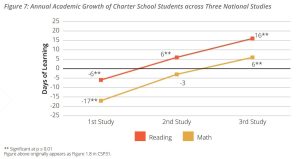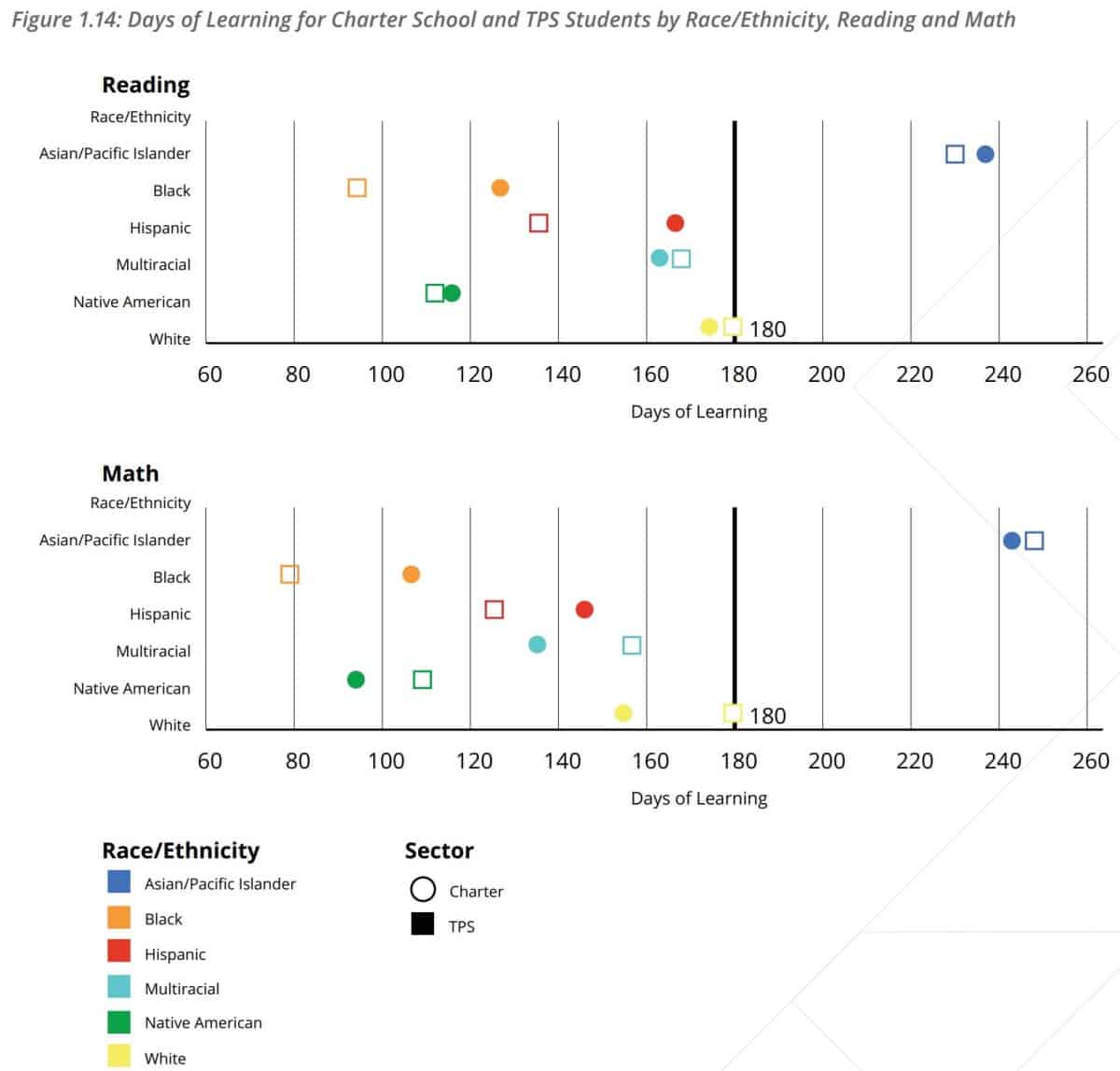A new study by Stanford University’s Center For Research on Education Outcomes (CREDO) shows that charter school students outperform traditional public school students. The study also shows consistent and significant gains over time for charter schools.
 CREDO’s third National Charter School Study found that, on average, charter school student get 16 more days of learning in reading and 6 more days in math in a school year compared to their matched peers in traditional public schools. The study also shows consistent growth in performance over time. The first CREDO study in 2009 showed better gains for minority students in charters, but on average, charter students got 6 fewer days of learning in reading and 17 fewer days in math. The 2013 study showed charter students outperformed traditional public schools by 6 days in reading and trailed by only 3 days in math. Now, the average charter student has better gains in both subjects.
CREDO’s third National Charter School Study found that, on average, charter school student get 16 more days of learning in reading and 6 more days in math in a school year compared to their matched peers in traditional public schools. The study also shows consistent growth in performance over time. The first CREDO study in 2009 showed better gains for minority students in charters, but on average, charter students got 6 fewer days of learning in reading and 17 fewer days in math. The 2013 study showed charter students outperformed traditional public schools by 6 days in reading and trailed by only 3 days in math. Now, the average charter student has better gains in both subjects.
The study also found that black and hispanic students, as well as students in poverty, have stronger growth than their traditional public school peers. However, gains are not equal to their white peers, creating learning gaps for many students. Across the three CREDO national charter school studies, annual charter student learning in reading has risen by 22 days and math learning has increased by 23 days. Charter Management Organization-affiliated schools advanced reading and math by 27 and 23 days, respectively, compared to traditional public schools, while stand-alone charter schools add 10 extra days of reading progress a year. Math remains equivalent. Students receiving Special Education services who attend charter schools have smaller learning gains than their matched peers in traditional public schools. Across the 31 data jurisdictions in the study, the spread between the state with the best learning result and the worst outcome is 109 days of learning in reading and 120 days in math.

“More than ever before, educators and policymakers need reliable examples of strong student learning that they can emulate to make up for past shortfalls,” said Dr. Margaret Raymond, director of CREDO at Stanford University. “The results of this study, along with the longer story of improvement by charter schools, provide critical insights that can accelerate student learning in more communities.”
One of the most common criticisms of charter schools is that they exacerbate educational inequities by selectively enrolling students or by having admission requirements that may disadvantage certain groups, leading to disparities in access and opportunity, and that charter schools have the ability to selectively admit students, which can lead to cherry-picking of students with better academic records, leaving traditional public schools with a higher concentration of challenging or disadvantaged students.
However, the study found that charter schools enroll and educate more diverse and academically challenged students than local traditional public schools.
Moreover, the study found, 36% of charter schools now have stronger annual gains than their local traditional public school in both reading and math, while weaker gains than traditional public-school alternatives have shrunk to 17% in reading and 25% in math. Additionally, more than 1,000 charter schools provide “gap-busting” learning with equitable progress across minority, poverty, and English language learner students relative to their more advantaged peers and create school-wide achievement that exceeds state averages.
Indeed, stronger gains relative to traditional public schools are found in elementary, middle, and high schools but not multi-level schools.
CREDO study not an outlier
Multiple studies have found school choice — whether it be private schools, charter schools or homeschool — works to improve outcomes for students across the board.
A study from Step Up for Students allays concerns school choice won’t work in rural areas. The study of 30 rural Florida counties confirms that school choice enrollment is growing in rural Florida and that more options are available.
The study found that — not only has school choice not significantly impacted public schools — it has actually improved outcomes.
According to Education Week, Florida now ranks No. 3 in the nation in K-12 achievement and has ranked in or near the Top 10 for a decade.
And while charter schools and universal choice in Kansas has floundered for years, other states have been steadily expanding.
Why charter schools outperform traditional public schools
Charter schools are public schools, so why do they produce much better results than traditional public schools? In a word, bureacracy; there is much less of it in charter schools.
Charter schools have more flexibility. Rather than being part of a public school district, which dictates curriculum and standards in all schools, charters operate autonomously through individual agreements, or charters, with state or local governments that dictate rules and performance standards. As standalone organizations, charters are ‘flatter’ than school districts that have layers of managment and therefore have the flexibility to try different approaches as the staff deems necessary.
Another aspect of being more flexible is that in most states, the vast majority of charter schools are not unionized because state laws exempt charters from a lot of rules, including, in most states, collective bargaining contracts. But while charter schools are not required to be unionized, they’re not prohibited, either.
Put differently, charter schools are student-focused, whereas most traditional public schools are system-driven. Traditional public school boards could theortetically jettison much of the bureaucracy and state boards of education could petition state legislatures to be freed of mandatory collective bargaining regulations. But that is unlikely because many state and local school board members are elected with the backing of unions and education organizations that have a ‘system over students’ mentality that is detailed in Giving Kids a Fighting Chance with School Choice, a book published by the Sentinel’s parent company, Kansas Policy Institute. It tells one story after another of education officials consciously deceiving parents and legislators…de-emphasizing academic preparation…and even ignoring state laws designed to improve outcomes and close achievement gaps.
KNEA, KASB, Kansas Board of Education mum on CREDO study
The Sentinel reached out to the Kansas National Education Association, the Kansas Board of Education and the Kansas Association of School Boards about the CREDO study.
The Sentinel wanted to know what lessons could be learned by traditional public schools from the study.
Predicatably, none of those system-focused organizations responded.



